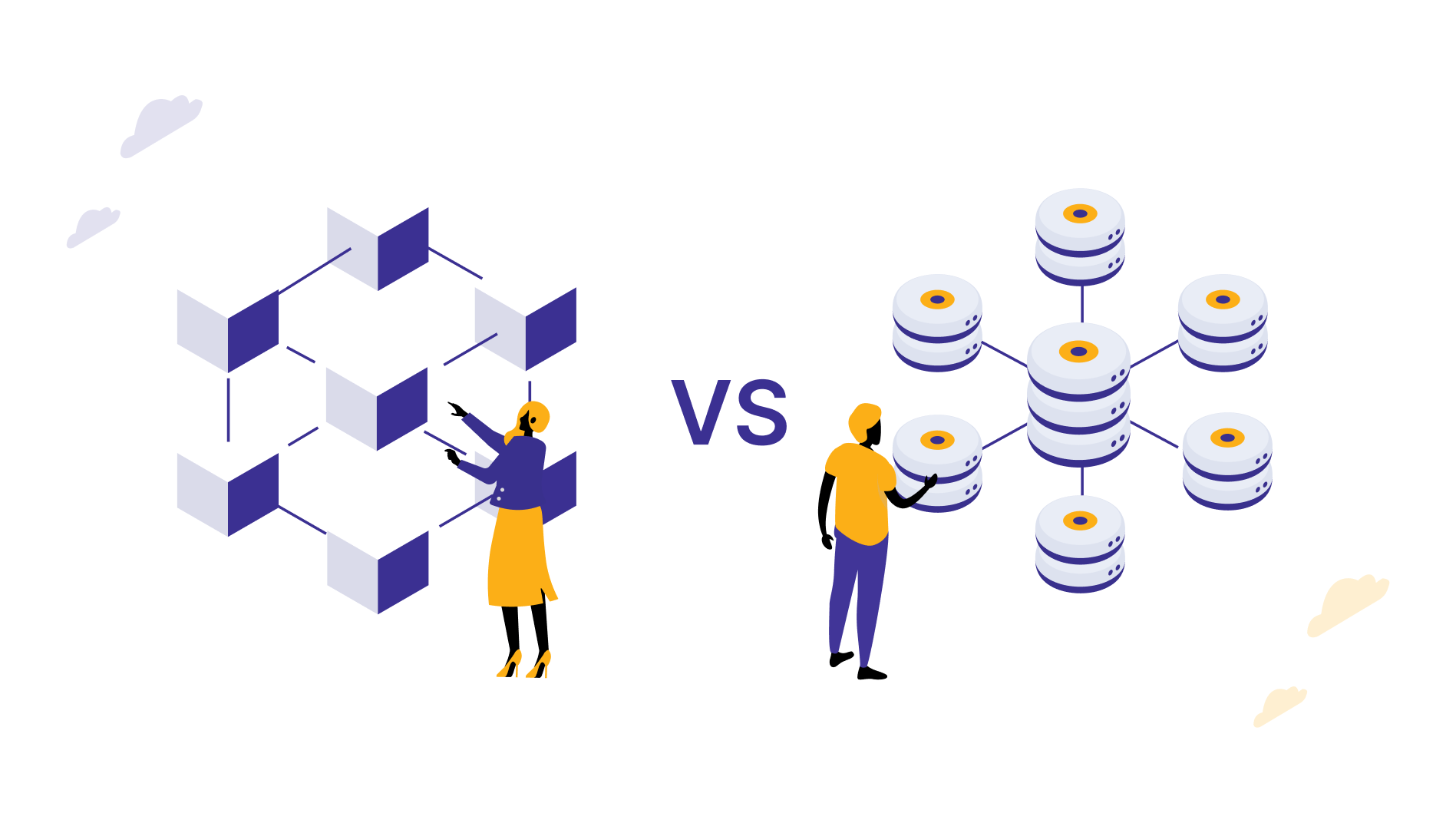Data mesh vs data fabric: Understand the differences
Data fabric vs. data mesh are both modern data architectures. But, their data management and governance principles are different. While data mesh helps organizations run domain-based data management, data fabric integrates data into one ecosystem, making it accessible in one place.

Suresh
Sep 18, 2024 |
7 mins

What is a data mesh?
Data mesh is a decentralized data management concept where every domain, division, or region of a company is managed as separate entities. This is great for organizations with data ownership and management challenges.
Characteristics of data mesh:
Self-serve infrastructure for each domain to control data sharing, access, etc.
Data is treated like a product and every domain is accountable for maintaining, documenting and scaling their own data.
Centralized governance, but decentralized data ownership and control.
Despite centralized security and compliance standards, every domain gets some flexibility to choose what’s best, without affecting consistency.
Data mesh is suitable for large and globally distributed organizations with complex functional units and divisions and each struggling to get their autonomy.
What is data fabric?
Data fabric, opposite of data mesh, centralizes storage and data management from all locations - on premise, cloud, hybrid environments, etc. So, the data view across the organization becomes unified, ensuring consistency and secure data usage across organizations.
Characteristics of data fabric
Hybrid environment functionality: Ensures that data from different sources are integrated into a unified interface, breaking down cross-platform access challenges.
The company could easily exercise control and governance over the data, especially complex regulations like GDPR, HIPAA, etc.
Meta-data driven approach: Automated data discovery, lineage, and cataloging to ensure the right and effective usage of data.
Data fabric architecture is suitable for companies struggling with hybrid environments, wanting to reduce complexities, simplify management, and regulate compliance.
Recommended read: What are data marts?
Data mesh and data fabric architecture
Data mesh architecture contains three layers, self-serve data platform layer, domain-oriented data product layer, and governance layer.
Domain-oriented data product layer: Data mesh lets domain owners treat data as a product and hand them everything from metadata to ETLs to APIs. This allows domain owners to aggregate and process the data, making it consumable for respective users.
Self-serve data platform layer: Every domain gets infrastructure and control through this layer to handle data products and related workloads. The layer comes with data ingestion, processing, and storage tools to make analytics available through a self-service reporting platform.
Governance layer: This is the governance and security layer needed to control the decentralized data infrastructure without affecting its autonomy. It also contains data catalogs, automated governance tools for access controls, and governance flexibilities offered to each domain.
Data fabric comes with five layers and its architecture is different from data mesh.
Metadata management: Being known as the backbone of data fabric, metadata management collects, organizes and stores metadata - the data about your data.
Data integration layer: The connecting tools and ETL/ELT pipelines responsible for ingesting data from multiple sources into one central layer.
Data governance: The principles and policies about identity and access management, encryption, masking, etc., that the organization must follow.
Data access layer: Business users get access to data through APIs, business intelligence tools, or visualization.
AI workloads: Workflows enabled for data preparation and transformation to make it suitable for AI use cases.
Recommended read: Why is data cleansing important?
Is the data mesh the same as that of data fabric?
No. data mesh and data fabric are not and are two different data architecture concepts. Both concepts aim to fix modern data challenges that arise to increasing data sources. However, their philosophy, key principles, and architecture are entirely different. Some differences between data mesh and data fabric is discussed below:
Factors | Data mesh | Data fabric |
Philosophy | Decentralized approach | Centralized approach |
Ownership | Domain owners manage data products | Ownership is central, connecting all data sources, offering a unified view. |
Who should go for it? | Best for large organizations with equally large domains, where centralized monitoring may not work. | Data fabric is great for companies with hybrid data environments. |
Is it complex? | Might require culture shifts during the beginning. Training required for users to handle self-service analytics without the IT team’s intervention. | Difficult to identify and connect many data sources. But requires no restructuring or cultural shift. |
Governance | Federated governance with a certain liberty given to domains | Centralized governance and security policies that’s same across the organization. |
Benefits of data mesh
Scalability: Easy to scale infrastructure, resources, and compute based on each domain’s requirements as they grow.
Fast data availability: every domain controls its own data, ensuring fast data availability for any use case it manages.
Encourages autonomy with collaboration: Every domain is free to handle their data products while easily sharing data and collaborating with others.
Simplifies data for non-tech users too: Business users with no knowledge of data tools could still use self-service analytics and make data a part of their decision making.
Better reliability: Domains treat their own data as a product, ensuring high reliability and quality.
Benefits of data fabric
Unified data access: Data fabric connects all disparate sources from heterogeneous environments to one central repository for better management and scalability.
Real-time data availability: Once set up, data reaches the enterprise layer fast, ensuring fast availability for real-time analytics and AI use cases.
Less IT costs: IT costs will be comparatively less, as there is no data duplication or cost required to maintain siloed, domain-based architecture.
Easy governance management: The governance principles and access controls are the same for the entire organization. So, data and IT teams can easily manage without risks and safety compromises.
Metadata-driven: Automated data discovery, cataloging, and quality checks because of the metadata-driven approach, reduces people and effort required.
High data quality: No siloed data source, centralized standards and control ensure high data quality, bringing the trust factor.
Can you use data mesh and data fabric together?
Yes. You can use both data mesh and data fabric together, benefiting from the strengths of each architecture.
Use domain based architecture using data mesh to manage data products and use data fabric to facilitate the underlying architecture that connects everything together. This enables seamless integration and interoperability in your company.
There are many advantages of using data fabric and mesh together. One of them is high quality and seamless data products access for everyone. Also, this reduces implementation and operational complexity while minimizing data duplication and high costs happen due to that. You can have a flexible and scalable data foundation that supports future goals.
Should you choose data fabric or data mesh?
Some points you should consider to find which is suitable for your organization - data fabric or data mesh?
Choose data fabric when
Your company operates on hybrid, multi-cloud, or a combination of all environments and needs a unified management.
Your data sources are diverse and integration tasks are complex for you.
Real-time analytics and high-processing capabilities are your priority
Your business belongs to a highly regulated industry with strict compliance requirements.
Providing easy and fast access to data to business users without complicating the access or burdening them with additional management responsibilities.
Wants automated metadata management, ETL, and validation checks.
Choose data mesh when
Scalable data management is your priority.
You want to offer flexibility and autonomy to each of your departments.
Your organization is ready to go through a cultural change and give data ownership to every department and user.
Data quality management process and standards are high for your organization.
Your organization is large, and it's hard to manage domains and their varying data requirements.
Use the above data mesh guide as a checklist to find out what suits your organization - data mesh or data fabric.
You can combine both as suggested in the previous section, if you are a large organization with diverse data platforms, processing specifications, and scalability issues.
Final thoughts
Choosing between data mesh and data fabric boils down to your organization’s data needs and business goals. Data mesh comes with the positives of decentralized data ownership, scalability as your company grows, and data being treated as its respective domain’s own property. On the other hand, data fabric offers an intelligent framework for combining data sources and obtaining real-time data processing capabilities.
Evaluate your long-term plans and current data landscape to choose either one of these modern data architectures. Request a strategy call with our data specialists to identify the optimal data layer for your company.
Mesh, fabric, or hybrid—let’s engineer it right. Explore our data engineering services.

by Suresh
Suresh, the data architect at datakulture, is our senior solution architect and data engineering lead, who brings over 9 years of deep expertise in designing and delivering data warehouse and engineering solutions. He is also a Certified Fabric Analytics Engineer Associate, who plays a major role in making us one of the early adopters of Fabric. He writes in words whatever he delivers with precision to his clients, consistently voicing out trends and recent happenings in the data engineering sector.



